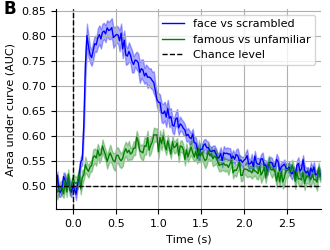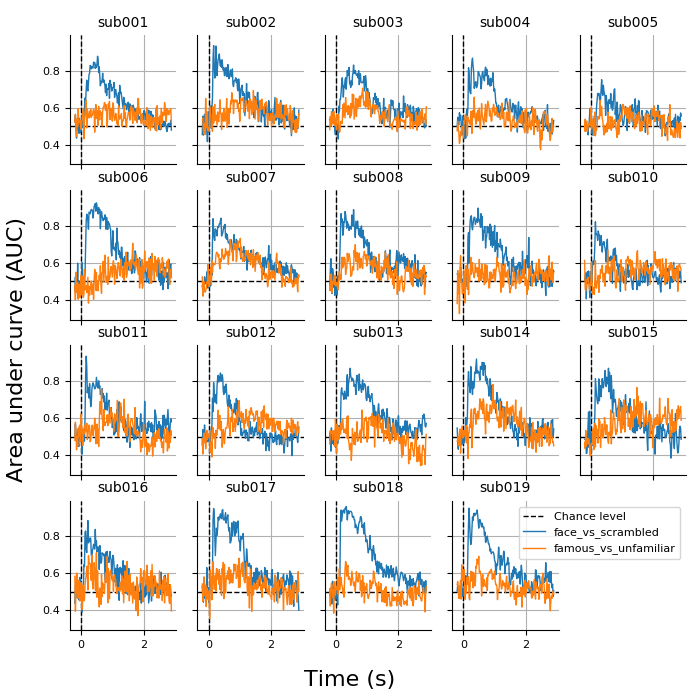Decoding (ML) across time (MEG)¶
A sliding estimator fits a logistic regression model for every time point. In this example, we contrast the condition ‘famous’ vs ‘scrambled’ and ‘famous’ vs ‘unfamiliar’ using this approach. The end result is an averaging effect across sensors. The contrast across different sensors are combined into a single plot.
Analysis script: Sliding estimator
Let us first import the necessary libraries
import os
import os.path as op
import sys
import numpy as np
import matplotlib.pyplot as plt
from scipy.io import loadmat
from scipy.stats import sem
sys.path.append(op.join('..', '..', 'processing'))
from library.config import (meg_dir, l_freq, annot_kwargs, tmax,
set_matplotlib_defaults) # noqa: E402
Now we loop over subjects to load the scores
a_vs_bs = ['face_vs_scrambled', 'famous_vs_unfamiliar']
scores = {'face_vs_scrambled': list(), 'famous_vs_unfamiliar': list()}
for subject_id in range(1, 20):
subject = "sub%03d" % subject_id
data_path = os.path.join(meg_dir, subject)
# Load the scores for the subject
for a_vs_b in a_vs_bs:
fname_td = os.path.join(data_path, '%s_highpass-%sHz-td-auc-%s.mat'
% (subject, l_freq, a_vs_b))
mat = loadmat(fname_td)
scores[a_vs_b].append(mat['scores'][0])
… and average them
Let’s plot the mean AUC score across subjects
set_matplotlib_defaults()
colors = ['b', 'g']
fig, ax = plt.subplots(1, figsize=(3.3, 2.5))
for c, a_vs_b in zip(colors, a_vs_bs):
ax.plot(times, mean_scores[a_vs_b], c, label=a_vs_b.replace('_', ' '))
ax.set(xlabel='Time (s)', ylabel='Area under curve (AUC)')
ax.fill_between(times, mean_scores[a_vs_b] - sem_scores[a_vs_b],
mean_scores[a_vs_b] + sem_scores[a_vs_b],
color=c, alpha=0.33, edgecolor='none')
ax.axhline(0.5, color='k', linestyle='--', label='Chance level')
ax.axvline(0.0, color='k', linestyle='--')
ax.legend()
ax.set(xlim=[-0.2, tmax])
ax.annotate('B', (-0.15, 1), **annot_kwargs)
fig.tight_layout(pad=0.5)
fig.savefig(op.join('..', 'figures', 'time_decoding_highpass-%sHz.pdf'
% (l_freq,)), bbox_to_inches='tight')
plt.show()

It seems that ‘famous’ vs ‘unfamiliar’ gives much noisier time course of decoding scores than ‘faces’ vs ‘scrambled’. To verify that this is not due to bad subjects:
fig, axes = plt.subplots(4, 5, sharex=True, sharey=True,
figsize=(7, 7))
axes = axes.ravel()
for idx in range(19):
axes[idx].axhline(0.5, color='k', linestyle='--', label='Chance level')
axes[idx].axvline(0.0, color='k', linestyle='--')
for a_vs_b in a_vs_bs:
axes[idx].plot(times, scores[a_vs_b][idx], label=a_vs_b)
axes[idx].set_title('sub%03d' % (idx + 1))
axes[-1].axis('off')
axes[-2].legend(bbox_to_anchor=(2.2, 0.75), loc='center right')
fig.text(0.5, 0.02, 'Time (s)', ha='center', fontsize=16)
fig.text(0.01, 0.5, 'Area under curve (AUC)', va='center',
rotation='vertical', fontsize=16)
fig.subplots_adjust(bottom=0.1, left=0.1, right=0.98, top=0.95)
plt.show()

Total running time of the script: ( 0 minutes 2.530 seconds)